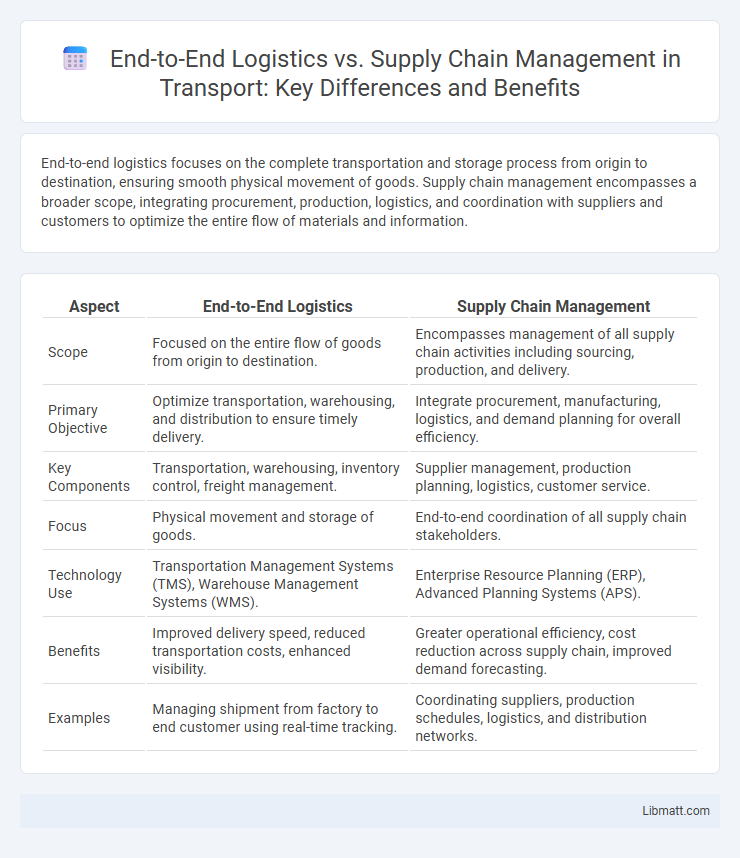End-to-end logistics focuses on the complete transportation and storage process from origin to destination, ensuring smooth physical movement of goods. Supply chain management encompasses a broader scope, integrating procurement, production, logistics, and coordination with suppliers and customers to optimize the entire flow of materials and information.
Table of Comparison
| Aspect | End-to-End Logistics | Supply Chain Management |
|---|---|---|
| Scope | Focused on the entire flow of goods from origin to destination. | Encompasses management of all supply chain activities including sourcing, production, and delivery. |
| Primary Objective | Optimize transportation, warehousing, and distribution to ensure timely delivery. | Integrate procurement, manufacturing, logistics, and demand planning for overall efficiency. |
| Key Components | Transportation, warehousing, inventory control, freight management. | Supplier management, production planning, logistics, customer service. |
| Focus | Physical movement and storage of goods. | End-to-end coordination of all supply chain stakeholders. |
| Technology Use | Transportation Management Systems (TMS), Warehouse Management Systems (WMS). | Enterprise Resource Planning (ERP), Advanced Planning Systems (APS). |
| Benefits | Improved delivery speed, reduced transportation costs, enhanced visibility. | Greater operational efficiency, cost reduction across supply chain, improved demand forecasting. |
| Examples | Managing shipment from factory to end customer using real-time tracking. | Coordinating suppliers, production schedules, logistics, and distribution networks. |
Understanding End-to-End Logistics
End-to-end logistics encompasses the complete process of planning, implementing, and controlling the efficient movement and storage of goods from the point of origin to the final destination. It integrates transportation, warehousing, inventory management, order fulfillment, and distribution, ensuring seamless coordination across all stages. Effective end-to-end logistics enables businesses to reduce costs, improve delivery speed, and enhance customer satisfaction within the broader framework of supply chain management.
Defining Supply Chain Management
Supply Chain Management (SCM) encompasses the strategic coordination of all activities involved in sourcing, procurement, production, and distribution to deliver products efficiently from suppliers to customers. Unlike end-to-end logistics, which primarily focuses on the transportation and warehousing aspects, SCM integrates demand planning, inventory management, supplier relationships, and customer service. Your understanding of SCM helps optimize the entire supply process, ensuring timely delivery and cost-effective operations across multiple functions.
Key Differences Between End-to-End Logistics and Supply Chain Management
End-to-end logistics primarily focuses on the efficient movement and storage of goods from origin to final delivery, emphasizing transportation, warehousing, and order fulfillment. Supply chain management encompasses a broader scope, integrating procurement, production planning, demand forecasting, and supplier relationships alongside logistics functions. Understanding these key differences helps you optimize operational efficiency by aligning logistics execution with overall supply chain strategy.
Objectives and Goals of Each Approach
End-to-end logistics focuses on the seamless movement and storage of goods from the point of origin to the final destination, aiming to optimize transportation efficiency, reduce delivery times, and lower costs. Supply chain management encompasses a broader scope, integrating procurement, production planning, inventory control, and customer demand forecasting to achieve overall operational efficiency and strategic alignment. Understanding these distinct objectives helps You tailor strategies that enhance both logistical execution and comprehensive supply chain performance.
Core Components of End-to-End Logistics
Core components of end-to-end logistics include freight management, inventory control, order fulfillment, and transportation coordination, all integrated to ensure seamless movement of goods from origin to destination. Advanced tracking systems and real-time data analytics support visibility and efficiency throughout the entire logistics process. Your business benefits from reduced delays, optimized resource allocation, and enhanced customer satisfaction through comprehensive end-to-end logistics management.
Essential Elements of Supply Chain Management
Supply chain management encompasses the essential elements of sourcing, production, inventory management, and distribution, integrating these functions into a cohesive system to optimize efficiency and customer satisfaction. End-to-end logistics, focusing primarily on the seamless movement and storage of goods from origin to final delivery, supports supply chain management by ensuring timely transportation, warehousing, and order fulfillment. Effective supply chain management relies on coordination across suppliers, manufacturers, and logistics providers, leveraging technology such as ERP systems and real-time tracking to enhance visibility and responsiveness.
Advantages of End-to-End Logistics
End-to-end logistics offers comprehensive control over the entire movement of goods, enhancing visibility and efficiency from origin to delivery. This approach reduces delays and minimizes costs by streamlining processes such as inventory management, transportation, and order fulfillment. Companies benefit from improved customer satisfaction and real-time tracking through integrated technology systems in end-to-end logistics.
Benefits of Comprehensive Supply Chain Management
Comprehensive supply chain management offers enhanced visibility and coordination across all stages, from procurement to delivery, reducing delays and optimizing resource allocation. It improves demand forecasting accuracy and inventory management, leading to cost savings and higher customer satisfaction. Your business gains agility and resilience, enabling swift responses to market changes and disruptions.
Choosing the Right Strategy for Business Needs
Choosing the right strategy for business needs involves understanding that end-to-end logistics focuses on the efficient movement and storage of goods from origin to customer, while supply chain management encompasses a broader scope including procurement, production, and demand forecasting. Businesses with complex operations and multiple suppliers benefit from integrated supply chain management to optimize costs and improve responsiveness. For companies prioritizing streamlined distribution and delivery, end-to-end logistics offers targeted solutions that enhance operational efficiency and customer satisfaction.
Future Trends in Logistics and Supply Chain Management
Emerging technologies like AI, blockchain, and IoT are transforming end-to-end logistics and supply chain management by enhancing transparency, efficiency, and real-time decision-making. Sustainable practices and autonomous vehicles are becoming critical trends, driving companies to optimize routes and reduce carbon footprints across the entire supply chain. Your business can leverage these innovations to stay competitive in a rapidly evolving marketplace focused on agility and environmental responsibility.
end-to-end logistics vs supply chain management Infographic

 libmatt.com
libmatt.com